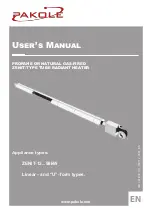
Reznor, Guardian GB GR and GS, Installation Manual, EN 2020-06, D30121 Iss B Page No 33
FF
Fault finding.
General
All Air Curtains are fitted with fuse protection and
motor thermal protection.
Other faults in relation to the element, motor and
wiring should be identified using conventional fault-
finding techniques.
In the event that electrical components are replaced,
please ensure that electrical safety checks in
accordance with the regulations in force in the
country of use are undertaken.
Electric heated units only.
For the service engineer, please note that there is a
thermal cut-out incorporated in the air curtain which
needs to be manually reset. The cut-out is located
near to the control panel, note 2m has two, with the
second located near the centre of the fan deck.
Re-setting the thermal cut-out may help to
identify the nature of the fault however we do
not recommend re-setting without a thorough
investigation into why the cut-out operated.
Figure 31 Thermal cut-out
Program panel.
The SmartElec3 circuit board within the electric
heated models will communicate any potential faults
to the program panel. Fault codes are displayed on
the program panel as a code with a prefix “E” e.g.
[0 E6]
The first number represents the air curtain
address.
For fault codes refer to SmartElec fault table on page
34
As the faults are mutually exclusive,
the first error
code displayed on the program panel will stay on
until the fault has been cleared.
Apart from the communication failure fault
[0 --]
which could be due to a broken connection of the
data link and the air curtain not found fault,
which could be due to incorrect addressing, all other
faults will cause the base unit to switch off the
heater output.
The SmartElec circuit board is protected from any
short circuit of the air sensor
[0 E1]
or heat
sink sensor
[0 E4]
as the error will cause the
temperature to rise and trigger over temperature
fault.
[0 E1]
There are five basic checks to perform should ‘X--’
[0 --]
appear on the program panel display.
These are as follows:
• Continuity:
Use a multimeter to check
continuity between each end of the cable cores.
• Short circuit:
Use a multimeter to check that
there are no short circuits between any of the
cable cores.
• Plugs:
Check that the plugs are firmly seated in
the circuit board sockets in both the program
panel and on the circuit board .
• Addressing:
(Network versions only). If two or
more air curtains are networked, check that each
base unit has a unique address as described in
air
curtain addressing on page 22.
• Network cables:
Ensure that the total run of
all cables in the network does not exceed 100m
including the cable to the program panel.
E rr
0 --
0 E1
0 E4
0 E1
0 --
0 E6








































